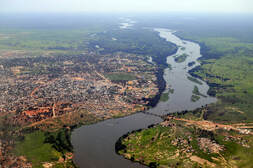Before showing the degree to which GERD has changed the hydro-political dynamics in the basin, it looks logical to give some technical information about the dam. It is located about 40 kms east of the Ethio-Sudan boundary on the floor of the Guba Valley in the Blue Nile Basin. The dam’s reservoir would hold about 74 billion cubic meters (bcm) of water on 1700 km2 area, which is estimated to be twice the size of Lake Tana in Ethiopia. The 246 km long lake may require five or more years to reach its full capacity. GERD will tower 145 meters high and 1.8 km long and its total installed power generating capacity is estimated at 6000 MWs. It is expected to be operational by 2017. Due to the reluctance of multilateral agencies and development banks to fund the dam project, it remains a self-funding project. It needs USD 5 billion for completion (equivalent to Ethiopia’s annual budget), which is unadjusted for cost overruns[3]. By aligning with Ethiopia on GERD question, Sudan has disavowed the ‘strategic pact’ it made with Egypt, i.e. the 1959 agreement. The question is why has Sudan decided to support the construction of the Grand Ethiopian Renaissance Dam? Some seven reasons could be spelled out to justify Sudan’s position: (a) the dam will siphon off more water for downstream irrigation, (b) Sudan would get a regulated and sustained water flow (the minimum and maximum flow that used to be 200m3/s and 6500 m3/s, respectively, could be changed to 3600-3800 m3/s throughout the year), (c) the dam will hold back immense quantities of silt and sediments (could result in 86% reduction), (d) it can prolong the life-span of Sudanese dams, such as the Rosaries Dam on the Blue Nile, (e) it will reduce flooding and improve flood control, (f) Sudan can get surplus and cheaper electricity to deliver to its power-hungry population (with 25% of the cost from Merowe Dam) and (g) Sudan also wanted to show its disaffection with previous agreements (most particularly with the 1959 Agreement). Cairo’s worries about GERD stem from two factors. First, they think the dam will reduce the flow of the Nile into Egypt during the reservoir filling-in years[4] and second the dam could cause permanent reduction that can come as a result of evaporation from the reservoir. Egyptians have taken various measures to thwart the construction of GERD. These include, among others, (a) lobbying the Italians so that Salini Impregilo Construction Firm, in short Salini[5], can halt the construction of the dam, (b) approaching the EU, US, China, Saudi Arabia, the UAE, Japan, the WB etc. and lobbying them to stand on their side, (c) contemplating to take the case to the International Court of Justice and the UN Security Council, (d) blackmailing the construction of the dam as a violation of international legal principles (the no-harm rule), (e) coming up with the idea of using dam busters to “smash and thrash GERD”, (f) whipping up a fierce anti-Ethiopian sentiments through state and private medias in Egypt and (g) proposing further studies on the dam’s design and impact on downstream countries. By way of conclusion, I can say that the most feasible way out for Egypt lies in working with the other riparian states. As stated by Verhoeven, “Instead of fearing the dam, Egypt should see it as an opportunity to move closer to a region it has traditionally spurned”. Egypt needs to wake up to the new reality and the changing political/regional dynamics in the region by accepting the rights of the upstream states within the framework of the Cooperative Framework Agreement (CFA)[6]. The construction of GERD would compel Egypt to think out of the box by changing the old attitudes which led to the current dead end. In view of the changing hydro-political dynamics, the 1929 and 1959 Nile Water Agreements have no chance of survival. And yet ratifying the CFA without the inclusion of the two principal Nile riparian states, namely Egypt and Sudan, could cement divides than cooperation in the basin. All efforts should be made to bring both riparian states onboard. Of late, we see a civil, reciprocal and mutual dialogue among the three principal Nile basin states, viz. Egypt, Ethiopia and the Sudan. The Declaration of Principles (DoP) that was signed by the three protagonists on March 25, 2015 is a good example for this and a step in the right direction. Works Cited
0 Comments
Your comment will be posted after it is approved.
Leave a Reply. |
Archives
October 2023
Categories
All
|
Copyright © 2023 The Zambakari Advisory - Privacy Policy
Our site uses cookies to improve your experience. You can control cookies by adjusting your browser or device settings.
If you continue without changing your settings, we assume that you are happy to receive all cookies.
If not, please feel free to opt out here.
SEO by Qasim Khilji
Our site uses cookies to improve your experience. You can control cookies by adjusting your browser or device settings.
If you continue without changing your settings, we assume that you are happy to receive all cookies.
If not, please feel free to opt out here.
SEO by Qasim Khilji

